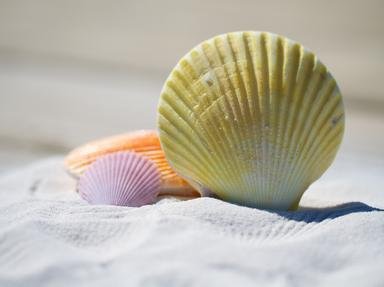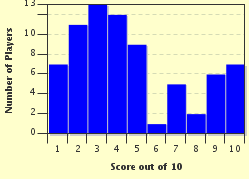Quiz Answer Key and Fun Facts
1. The pictured 'Clinocardium nuttallii' is a large, edible saltwater bivalve mollusc. It is one of many species in the 'Cardiidae' family, which can be found living in sheltered, sandy beaches around the world. By what general name are members of this family known?
2. The pictured shell belongs to the 'Arcinella cornuta', a species of bivalve mollusc native to the southeast coast of North America. This is one of numerous species in the 'Chamidae' family which are known collectively by what name?
3. You may be surprised to discover that not all molluscs are entirely enclosed within shells. 'Panopea generosa' is a large, edible, saltwater clam native to the west coast of North America. What type of mollusc is this?
4. 'Donax' is a genus of bivalve mollusc often seen on beaches as the tide retreats, washing them out of the sand (although they quickly dig themselves back in). The pictured 'Donax vittatus', the banded wedge shell, is a native of beaches in northwestern Europe. By what common name are species within the 'Donax' genus widely known?
5. Native to North America's eastern seaboard and the Gulf of Mexico, 'Crassostrea virginica' is also farmed commercially in Washington state's Puget Sound, where it is known as a Totten Inlet Virginica. The state shellfish of Connecticut and the state shell of both Mississippi and Virginia, what type of mollusc is this?
6. The pictured 'Atrina rigida' is a bivalve mollusc native to the eastern Atlantic Ocean coast from Brazil to North Carolina and throughout the Caribbean islands. An ancient creature, fossils of this species and its cousins in the 'Pinnidae' family have been found worldwide dating back almost 250 million of years. What sort of mollusc is this?
7. One way in which our next animal family is unusual is that its shell is inside its body. It also has eight arms and two tentacles, each armed with suckers equipped with numerous teeth. Oh, and they also feed on other molluscs. The pictured species is 'Metasepia pfefferi', a native of Indo-Pacific waters. What types of creature is this?
8. The 'Teuthida' order contains more than 300 species of this cephalopod. Strong swimmers, many of them live in the dark depths of the oceans, but some can also fly out of the water for short distances. The pictured species is 'Cranchia scabra', one of the smaller members of the order. What type of creature is this?
9. There are more than 900 species in the 'Polyplacophora' class. Consisting of a dorsal shell comprising eight overlapping plates surrounded by a girdle, chitons can cling to rocks or limp along the sea floor on their single foot. The pictured species, 'Tonicella lineata', is native to the north Pacific. By what common name are these creatures often known?
10. There are many families and superfamilies within the 'Patellogastropoda' clade, although some of them now containing only extinct species. The numerous extant species of marine gastropods molluscs within the clade all have cone-shaped shells and can usually be found adhered to rocks or other surfaces. The picture shows 'Fissurella volcano', a native of the western Pacific. Which type of creature is this?
Source: Author
EnglishJedi
This quiz was reviewed by FunTrivia editor
Tizzabelle before going online.
Any errors found in FunTrivia content are routinely corrected through our feedback system.

